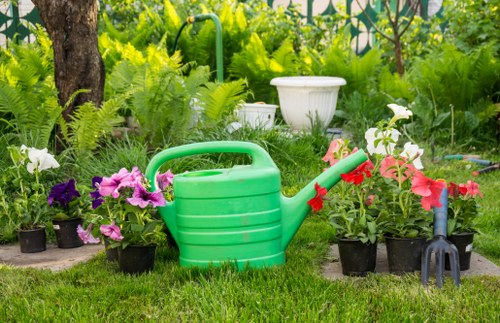Garden Fence Replacement Manor House

Replacing a garden fence at a manor house is a significant project that combines functionality with aesthetic appeal. Whether your manor house is nestled in a serene countryside or a bustling urban area, ensuring that your garden fence complements the grandeur of your property is essential.
Garden fences serve multiple purposes. They provide security, define boundaries, and enhance the overall landscape design. At a manor house, where the gardens are often expansive and meticulously maintained, the fence becomes a key element of the property's charm.
When considering fence replacement, it's crucial to choose materials and styles that reflect the historical and architectural significance of the manor house. This ensures that the new fence not only meets your needs but also preserves the estate's legacy.

Why Replace Your Garden Fence?
Over time, fences can deteriorate due to weather conditions, wear and tear, and other environmental factors. Replacing an old or damaged fence ensures that your garden remains secure and visually appealing.
Key reasons to replace your garden fence include:
- Improved security and privacy
- Enhanced curb appeal
- Increased property value
- Compliance with local regulations
- Maintenance and durability
Addressing these aspects not only maintains the integrity of your manor house but also provides peace of mind knowing that your garden is well-protected.

Choosing the Right Fence Material
Selecting the appropriate material is pivotal in fence replacement. Different materials offer varying levels of durability, maintenance, and aesthetic appeal.
Wood Fences
Wood fences are a popular choice for manor houses due to their classical look and versatility. They can be customized with various stains and paints to match the property's color scheme.
Metal Fences
Metal fences, such as wrought iron or aluminum, provide a robust and elegant option. They are known for their longevity and low maintenance requirements.
Vinyl Fences
Vinyl fences offer a modern alternative with a wide range of styles and colors. They are resistant to weathering and require minimal upkeep.

Design Considerations
The design of your garden fence should harmonize with the architectural style of your manor house. Consider factors such as height, color, and decorative elements to create a cohesive look.
Height and Privacy
Determine the appropriate height based on your privacy needs and local regulations. Taller fences offer more privacy, while shorter ones can enhance visibility and openness.
Color and Finish
Choose colors that complement the exterior of your manor house. Natural wood tones or classic white are timeless choices, while bold colors can make a statement.
Decorative Features
Incorporate decorative elements like finials, scrolls, or lattice work to add character to your fence. These details can reflect the historical period of your manor house.

Installation Process
Proper installation is crucial for the longevity and stability of your garden fence. Hiring experienced professionals ensures that the fence is built to last.
Preparation
Before installation, assess the current fence condition and clear the area of any obstacles. Accurate measurements and planning are essential for a seamless replacement process.
Installation Steps
- Remove the old fence
- Prepare the posts and ensure they are level
- Assemble the new fence panels
- Secure the panels to the posts
- Add finishing touches and inspections
Post-Installation Maintenance
Regular maintenance, such as cleaning and periodic inspections, helps preserve the fence's appearance and functionality over time.

Cost Considerations
Replacing a garden fence can involve various costs, including materials, labor, and any additional features. Understanding these costs helps in budgeting effectively.
- Material Costs: Vary depending on the type of material chosen.
- Labor Costs: Professional installation typically ensures quality work.
- Additional Features: Decorative elements or custom designs may incur extra expenses.
Investing in high-quality materials and skilled labor might have a higher upfront cost but can result in long-term savings due to durability and reduced maintenance needs.

Permits and Regulations
Before embarking on a fence replacement project, it's essential to be aware of local building codes and regulations.
Permits
Some areas require permits for fence installation, especially if the fence exceeds a certain height or is located near property boundaries.
Homeowner Associations (HOAs)
If your manor house is part of an HOA, ensure that your fence replacement plans adhere to their guidelines and obtain necessary approvals.
Neighbor Considerations
Maintaining good relations with neighbors involves respecting property lines and discussing any significant changes that may affect them.

Environmental Impact
Considering the environmental impact of your fence materials and installation process is vital for sustainable living.
Eco-Friendly Materials
Opt for materials that are sustainably sourced or recyclable. Wood from certified forests or recycled metal options are excellent choices.
Installation Practices
Minimize environmental disruption by carefully planning the installation process to protect existing flora and fauna in your garden.
Long-Term Sustainability
Select materials that withstand local weather conditions to reduce the need for frequent replacements and minimize waste.

Enhancing Aesthetics
A well-designed fence can significantly enhance the beauty of your manor house's garden. Here are some ideas to elevate your garden fence:
Incorporate Plants
Climbing plants or vines can add a natural touch and soften the appearance of the fence. Flowers and greenery can bring vibrancy to the space.
Lighting
Integrate garden lighting into your fence design to highlight architectural features and provide safety during the evening hours.
Color Coordination
Match the fence color with other garden elements, such as pathways, flowers, and outdoor furniture, to create a harmonious look.

Selecting a Professional
Choosing the right professional for fence replacement is crucial for achieving the desired outcome.
Experience and Expertise
Look for contractors with experience in working on manor houses or similar properties. Their expertise ensures they understand the unique requirements and challenges.
Reputation
Check reviews, ask for references, and examine past projects to gauge the contractor's reliability and quality of work.
Quotes and Contracts
Obtain multiple quotes and ensure that all project details, timelines, and costs are clearly outlined in a written contract.

DIY vs. Professional Replacement
While some may consider a DIY approach for fence replacement, there are several factors to weigh before deciding.
Advantages of DIY
- Potential cost savings
- Personal satisfaction
- Flexibility in scheduling
Disadvantages of DIY
- Requires skill and tools
- Time-consuming
- Potential for errors and additional costs
For manor house owners seeking high-quality, long-lasting fences, hiring professionals is often the more reliable choice.

Maintenance Tips
Proper maintenance extends the life of your garden fence and keeps it looking pristine.
Regular Cleaning
Clean your fence periodically to remove dirt, debris, and prevent mold or mildew growth.
Inspect for Damage
Conduct regular inspections to identify and address any damage or wear before it escalates.
Repainting and Sealing
Repaint or reseal wooden fences to protect them from moisture and pests. Metal fences may require rust treatment to maintain their integrity.

Local Expertise in Manor House Areas
When replacing a garden fence at Manor House, leveraging local expertise ensures that the work aligns with regional styles and regulations.
Understanding Local Preferences
Local professionals are familiar with the aesthetic preferences and environmental conditions, allowing them to recommend the best materials and designs.
Access to Local Resources
They have access to local suppliers and resources, which can streamline the replacement process and potentially reduce costs.

Conclusion
Replacing a garden fence at a manor house is more than just a practical necessity; it's an opportunity to enhance the property's beauty and security. By carefully selecting materials, design, and professional services, you can achieve a stunning result that honors the elegance and history of your manor house.
Remember to consider local regulations, environmental impact, and maintenance requirements to ensure that your new fence serves you well for years to come.

Frequently Asked Questions
1. How long does a garden fence replacement take?
The duration of a fence replacement project depends on the size of the area, the type of materials used, and weather conditions. On average, it can take anywhere from a few days to a couple of weeks.
2. What is the most durable fence material for manor houses?
Metal fences, such as wrought iron or aluminum, are known for their durability and longevity, making them an excellent choice for manor houses.
3. Do I need a permit to replace my garden fence?
Permit requirements vary by location. It's essential to check with your local council or homeowner association to determine if a permit is needed for your fence replacement.
4. Can I customize the design of my new fence?
Yes, many fence materials offer customization options, including different styles, colors, and decorative elements to match your manor house's aesthetic.
5. How do I maintain my new garden fence?
Regular cleaning, inspections, and timely repairs are key to maintaining your fence. Additionally, applying protective coatings like paint or sealant can help preserve its appearance and functionality.